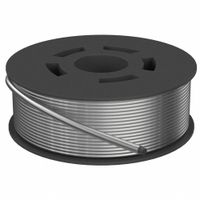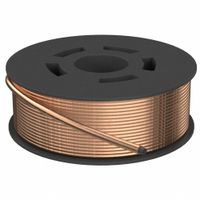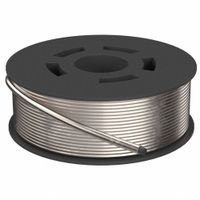Call +(254) 703 030 000 / 751 483 999 / 721 704 777
- Home
- Welding
- Filler Metals
- Welding Wire
- Flux Cored Welding Wire
.....Read More
Frequently Asked Questions
What is flux-cored welding wire used for?
Flux-cored welding wire is used in flux-cored arc welding (FCAW), a process that combines the benefits of shielded metal arc welding (SMAW) and gas metal arc welding (GMAW). It is designed for welding ferrous metals, including mild steel, stainless steel, and some nickel alloys. The wire consists of a metal sheath filled with flux compounds, which provide shielding from atmospheric gases, stabilize the arc, and add alloying elements to the weld pool.
Flux-cored wire is particularly useful in situations where high deposition rates and deep penetration are required. It is often employed in heavy fabrication industries, such as shipbuilding, construction, and pipeline welding, due to its ability to produce strong, high-quality welds quickly. The wire is available in two main types: self-shielded and gas-shielded. Self-shielded flux-cored wire does not require an external shielding gas, making it ideal for outdoor or windy conditions. Gas-shielded flux-cored wire, on the other hand, requires an external gas supply, typically carbon dioxide or a mix of argon and carbon dioxide, to protect the weld from contamination.
The advantages of using flux-cored welding wire include its versatility, ease of use, and ability to weld in various positions, including vertical and overhead. It also produces less spatter and slag compared to other welding methods, reducing cleanup time. However, it may require more skill to handle due to the potential for slag entrapment and requires proper ventilation to manage fumes. Overall, flux-cored welding wire is a valuable tool for achieving efficient, high-quality welds in demanding environments.
How do you choose the right flux-cored welding wire?
To choose the right flux-cored welding wire, consider the following factors:
1. **Base Material**: Match the wire to the type of metal being welded. For example, use a wire designed for carbon steel, stainless steel, or nickel alloys as needed.
2. **Welding Position**: Select a wire suitable for the welding position (flat, horizontal, vertical, or overhead). Some wires are all-position, while others are limited to specific positions.
3. **Shielding Gas**: Determine if the wire requires external shielding gas or is self-shielded. Gas-shielded wires provide cleaner welds but require gas cylinders, while self-shielded wires are more portable and suitable for outdoor use.
4. **Mechanical Properties**: Consider the required tensile strength, impact resistance, and ductility of the weld. Choose a wire that meets or exceeds these specifications.
5. **Diameter**: Select the appropriate wire diameter based on the thickness of the material and the welding machine's capabilities. Thicker materials generally require larger diameter wires.
6. **Welding Machine Compatibility**: Ensure the wire is compatible with your welding machine's voltage and amperage range.
7. **Environmental Conditions**: For outdoor or windy conditions, self-shielded wires are preferable as they are less affected by wind.
8. **Code and Specification Requirements**: Adhere to any industry standards or project specifications that dictate specific wire types or classifications.
9. **Cost and Availability**: Consider the cost-effectiveness and availability of the wire, balancing performance with budget constraints.
10. **Manufacturer Recommendations**: Follow the manufacturer's guidelines for wire selection to ensure optimal performance and warranty compliance.
By evaluating these factors, you can select the appropriate flux-cored welding wire for your specific application, ensuring strong, reliable welds.
What are the advantages of using flux-cored welding wire?
Flux-cored welding wire offers several advantages:
1. **High Deposition Rate**: Flux-cored wire provides a higher deposition rate compared to solid wire, which increases productivity and efficiency in welding operations.
2. **Versatility**: It can be used in various positions and is suitable for welding thick materials, making it versatile for different applications.
3. **Self-Shielding**: Some flux-cored wires are self-shielding, eliminating the need for external shielding gas. This is beneficial in outdoor or windy conditions where gas shielding might be disrupted.
4. **Deep Penetration**: The flux core allows for deeper penetration, which is advantageous for welding thicker sections and ensuring strong welds.
5. **Reduced Pre-Cleaning**: The flux in the wire helps to clean the weld area by removing impurities, reducing the need for extensive pre-cleaning of the base material.
6. **All-Position Welding**: Many flux-cored wires are designed for all-position welding, providing flexibility in various welding scenarios.
7. **Improved Mechanical Properties**: The flux can be formulated to enhance the mechanical properties of the weld, such as toughness and strength.
8. **Less Sensitivity to Contaminants**: Flux-cored wires are less sensitive to surface contaminants like rust or mill scale, which can be advantageous in less controlled environments.
9. **Reduced Spatter**: The flux helps to minimize spatter, leading to cleaner welds and reducing post-weld cleanup time.
10. **Cost-Effective**: While the wire itself may be more expensive, the increased efficiency and reduced need for additional equipment (like gas cylinders) can make it cost-effective in the long run.
These advantages make flux-cored welding wire a popular choice in construction, shipbuilding, and heavy equipment manufacturing.
Can flux-cored welding wire be used without gas?
Yes, flux-cored welding wire can be used without gas, but it depends on the type of flux-cored wire. There are two main types of flux-cored wires: self-shielded and gas-shielded.
Self-shielded flux-cored wires are designed to be used without an external shielding gas. They contain a flux core that, when heated during the welding process, generates gases and slag that protect the weld pool from atmospheric contamination. This makes them suitable for outdoor welding or in windy conditions where shielding gas might be blown away. They are commonly used for structural work, heavy equipment repair, and other applications where portability and ease of use are important.
Gas-shielded flux-cored wires, on the other hand, require an external shielding gas, typically a mixture of carbon dioxide and argon, to protect the weld area. These wires are generally used in indoor or controlled environments where the additional shielding gas can provide a cleaner weld with less spatter and better mechanical properties.
When using self-shielded flux-cored wire, it's important to ensure that the welding machine is set up correctly for the specific wire type and diameter. Proper technique and equipment settings are crucial to achieving a strong, clean weld. Additionally, self-shielded wires may produce more smoke and spatter compared to gas-shielded wires, so adequate ventilation and protective gear are necessary.
In summary, self-shielded flux-cored welding wire can be used without gas, making it versatile for various applications, especially in outdoor or remote locations. However, for applications requiring higher weld quality and appearance, gas-shielded flux-cored wires with external gas may be preferred.
What is the difference between flux-cored and solid welding wire?
Flux-cored welding wire and solid welding wire are both used in arc welding processes but differ in composition and application.
Flux-cored welding wire consists of a metal sheath filled with flux compounds. This design allows it to produce its own shielding gas when heated, which protects the weld pool from atmospheric contamination. There are two main types: self-shielded flux-cored wire, which doesn't require external gas, and gas-shielded flux-cored wire, which uses an additional shielding gas. Flux-cored wire is ideal for outdoor or windy conditions and is effective on dirty or rusty materials. It offers deep penetration and is suitable for thicker materials, making it popular in heavy industrial applications.
Solid welding wire, on the other hand, is a homogeneous wire without any internal flux. It requires an external shielding gas, such as argon or a mix of argon and carbon dioxide, to protect the weld area from contamination. Solid wire is typically used in MIG (Metal Inert Gas) welding and is preferred for clean, indoor environments. It provides a clean, smooth weld with minimal spatter and is ideal for thin materials and precision work.
In summary, the main differences lie in their composition and usage: flux-cored wire contains flux and can be used with or without external gas, making it versatile for various conditions, while solid wire requires external gas and is best suited for clean, controlled environments.
How do you store flux-cored welding wire to prevent moisture absorption?
To prevent moisture absorption in flux-cored welding wire, store it in a dry, controlled environment. Use the following methods:
1. **Sealed Packaging**: Keep the wire in its original, sealed packaging until use. Manufacturers often use vacuum-sealed or moisture-resistant packaging to protect the wire.
2. **Desiccant Packs**: Place desiccant packs inside the packaging or storage container to absorb any moisture present.
3. **Climate-Controlled Storage**: Store the wire in a climate-controlled room with low humidity. Aim for a relative humidity level below 60%.
4. **Temperature Control**: Maintain a stable temperature, ideally between 50°F and 80°F (10°C and 27°C), to prevent condensation.
5. **Storage Cabinets**: Use specially designed welding wire storage cabinets that are airtight and equipped with dehumidifiers or heaters.
6. **Plastic Bags**: If the original packaging is compromised, rewrap the wire in airtight plastic bags with desiccant packs.
7. **Avoid Direct Contact with Floors**: Store the wire off the ground on shelves or pallets to prevent exposure to moisture from the floor.
8. **Regular Inspection**: Periodically check the wire for signs of rust or moisture and replace desiccant packs as needed.
9. **First-In, First-Out (FIFO) Method**: Use older stock first to minimize the time wire is stored, reducing the risk of moisture absorption.
10. **Avoid Outdoor Storage**: Never store welding wire outdoors or in areas prone to high humidity or temperature fluctuations.
By following these practices, you can effectively minimize moisture absorption and maintain the quality and performance of flux-cored welding wire.
What are common problems encountered with flux-cored welding and how can they be fixed?
Common problems with flux-cored arc welding (FCAW) include:
1. **Porosity**: Caused by moisture, contaminants, or improper shielding gas. Fix by using dry, clean materials, ensuring proper gas flow, and maintaining a clean work environment.
2. **Slag Inclusion**: Occurs when slag is trapped in the weld. Prevent by using proper welding techniques, maintaining correct travel speed, and ensuring thorough cleaning between passes.
3. **Spatter**: Results from incorrect voltage or wire feed speed. Adjust settings, maintain proper electrode angle, and use anti-spatter spray.
4. **Burnback**: Happens when the wire melts into the contact tip. Fix by adjusting wire feed speed, maintaining correct stick-out, and ensuring proper contact tip size.
5. **Incomplete Fusion**: Caused by low heat input or incorrect technique. Increase voltage, adjust travel speed, and ensure proper electrode angle.
6. **Cracking**: Results from rapid cooling or high stress. Use preheat and post-weld heat treatments, select appropriate filler material, and control cooling rates.
7. **Excessive Penetration**: Occurs with high heat input. Reduce voltage, adjust travel speed, and maintain correct electrode angle.
8. **Undercutting**: Caused by excessive heat or incorrect technique. Reduce voltage, adjust travel speed, and maintain proper electrode angle.
9. **Wire Feeding Issues**: Result from improper tension or blockages. Check drive rolls, adjust tension, and ensure proper liner and tip size.
10. **Overlapping**: Occurs when weld metal rolls over the base metal. Adjust travel speed, maintain correct electrode angle, and ensure proper heat input.
Addressing these issues involves proper equipment setup, regular maintenance, and adherence to recommended welding procedures.



